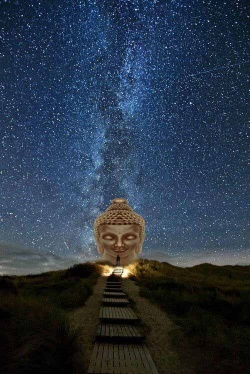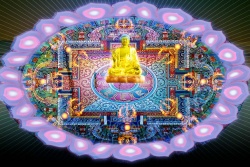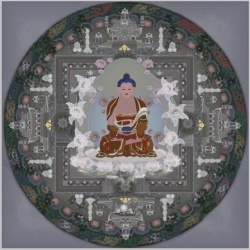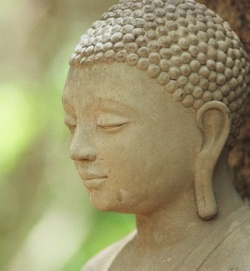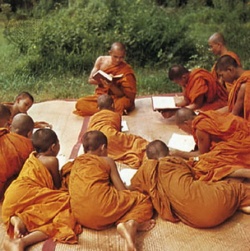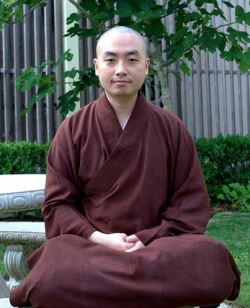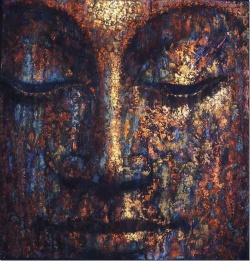Difference between revisions of "Vijñaptimātra: Mind Only a Guide to Freedom from Duality by Mausham Ratna Shakya"
(links) |
|||
| Line 20: | Line 20: | ||
===Description of [[Duality]] and [[Non-Duality]] in [[Vijñaptimātra]]=== | ===Description of [[Duality]] and [[Non-Duality]] in [[Vijñaptimātra]]=== | ||
| − | [[Vijñaptimātra]] is a [[doctrine]] of [[mind only]], also synonymously [[chittamātra]], [[cognition]] only, [[representation]] of [[mind only]] which describes the [[nature of mind]] and [[phenomena]], according to [[relative]] [[existential]] [[dualistic]] approach and it [[reality]] as [[non-dualistic]] approach. To be clear more I would like to go little bit deeper into [[mind]] and [[phenomena]]. Normally regarding [[mind]] we [[feel]] and realize the [[six consciousnesses]] related to [[six sense organs]] and [[feeling]] of ‘I’ as a [[mind]]. And [[phenomena]] as the [[physical world]] and [[metaphysical]] [[world]] beyond this [[Physical world]], which is partially true and Vashubandhu also agrees upon that but he also clarifies more profoundly which eliminates the [[duality]] of [[mind]] and [[phenomena]]. | + | [[Vijñaptimātra]] is a [[doctrine]] of [[mind only]], also synonymously [[chittamātra]], [[cognition]] only, [[representation]] of [[mind only]] which describes the [[nature of mind]] and [[phenomena]], according to [[relative]] [[existential]] [[dualistic]] approach and it [[reality]] as [[non-dualistic]] approach. To be clear more I would like to go little bit deeper into [[mind]] and [[phenomena]]. Normally regarding [[mind]] we [[feel]] and realize the [[six consciousnesses]] related to [[six sense organs]] and [[feeling]] of ‘I’ as a [[mind]]. And [[phenomena]] as the [[physical world]] and [[metaphysical]] [[world]] beyond this [[Physical world]], which is partially true and [[Vashubandhu]] also agrees upon that but he also clarifies more profoundly which eliminates the [[duality]] of [[mind]] and [[phenomena]]. |
===Analysis of [[Mind]]=== | ===Analysis of [[Mind]]=== | ||
| Line 36: | Line 36: | ||
According to [[Vasubandhu]] until the [[state of enlightenment]] the function of [[consciousness]] functions as [[imaginary]] [[experiences]], which are the projection of the [[mind only]]. For clear view the [[three consciousnesses]] are analyzed below; | According to [[Vasubandhu]] until the [[state of enlightenment]] the function of [[consciousness]] functions as [[imaginary]] [[experiences]], which are the projection of the [[mind only]]. For clear view the [[three consciousnesses]] are analyzed below; | ||
| − | ====1) | + | ====1) [[Pravritti Vijñāna]] ( [[Six Sense Consciousness]] )==== |
[[Six consciousnesses]] are associated with [[six sense organs]] they are 1) [[Eye]] 2) {{Wiki|Ear}} 3) {{Wiki|Nose}} 4) {{Wiki|Tongue}} 5) [[Body]] and 6) [[Mind]]. The [[six consciousnesses]] are thus called 1) [[Eye consciousness]] 2) [[Ear consciousness]] 3) [[Nose consciousness]] 4) [[Tongue consciousness]] 5) [[Body consciousness]] and 6) [[Mind consciousness]]. The [[six consciousnesses]] is a process of [[knowing]] process of [[objects]] related to the [[six organs]] and it is always changing and becomes a different [[experience]] in every moments<ref>{{Nolinking|Kochumuttom Thomas A., A Buddhist doctrine of experience, Delhi, Motilal banarasidas, 1982 page 138}}</ref>. | [[Six consciousnesses]] are associated with [[six sense organs]] they are 1) [[Eye]] 2) {{Wiki|Ear}} 3) {{Wiki|Nose}} 4) {{Wiki|Tongue}} 5) [[Body]] and 6) [[Mind]]. The [[six consciousnesses]] are thus called 1) [[Eye consciousness]] 2) [[Ear consciousness]] 3) [[Nose consciousness]] 4) [[Tongue consciousness]] 5) [[Body consciousness]] and 6) [[Mind consciousness]]. The [[six consciousnesses]] is a process of [[knowing]] process of [[objects]] related to the [[six organs]] and it is always changing and becomes a different [[experience]] in every moments<ref>{{Nolinking|Kochumuttom Thomas A., A Buddhist doctrine of experience, Delhi, Motilal banarasidas, 1982 page 138}}</ref>. | ||
| − | ====2) | + | ====2) [[Klista Manana Vijñāna]] ({{Wiki|Defiled}} “I” [[consciousness]])==== |
This [[consciousness]] depends on [[Ālaya Vijñāna]] ([[Store-consciousness]]), which is associated with [[four defilements]]. They are 1) [[belief in self]] (Ātma-dristi) 2) [[ignorance]] about [[self]] (Ātma-moha) 3) [[Pride]] in [[self]] (Ātma-māna) and 4) [[Love]] of [[self]] (Ātma-sneha). It is also associated with {{Wiki|Touch}} ([[sparsa]]), Attentiveness (manskara), [[Knowledge]] (Vit), Conceptions ([[sanjñā]]) and [[Wikipedia:Volition (psychology)|Volition]] ([[cetanā]]) with [[dualistic]] notion of [[self]] and others<ref>{{Nolinking|Dr Chatterjee K.N., Vasubandhu’s Vijñaptimātratāsiddi,Varanasi Kishor Vidhya Niketan, 1980 page 51}}</ref>. | This [[consciousness]] depends on [[Ālaya Vijñāna]] ([[Store-consciousness]]), which is associated with [[four defilements]]. They are 1) [[belief in self]] (Ātma-dristi) 2) [[ignorance]] about [[self]] (Ātma-moha) 3) [[Pride]] in [[self]] (Ātma-māna) and 4) [[Love]] of [[self]] (Ātma-sneha). It is also associated with {{Wiki|Touch}} ([[sparsa]]), Attentiveness (manskara), [[Knowledge]] (Vit), Conceptions ([[sanjñā]]) and [[Wikipedia:Volition (psychology)|Volition]] ([[cetanā]]) with [[dualistic]] notion of [[self]] and others<ref>{{Nolinking|Dr Chatterjee K.N., Vasubandhu’s Vijñaptimātratāsiddi,Varanasi Kishor Vidhya Niketan, 1980 page 51}}</ref>. | ||
| Line 54: | Line 54: | ||
[[Dharma]] Nairātmaya is the scheme of [[non-substantiality]] of [[objects]] and objectivity. {{Wiki|Modern}} [[scholars]] of different schools tries to establish the [[existence]] of [[phenomena]] as the real [[existing]] thing, similarly some [[philosophical]] schools like [[Vaishesika]] argues and tried to establish the [[existential]] [[nature]] of [[objects]] and objectivity with references to the {{Wiki|theory}} of {{Wiki|atom}}. They just accepted that [[objects]] and its [[experience]] are due to [[aggregates]] of [[atoms]]<ref>{{Nolinking|Sharma TR, Vijñaptimātrasiddhi, Delhi, Eastern Book Linkers, 1993 page 32}}</ref>. According to Vashubandhu if the [[causes]] of [[experience]] are due to {{Wiki|atom}} then the [[reality]] could be [[conceived]] either as a single [[entity]] or as many discrete [[atoms]], or [[aggregates]] of {{Wiki|atom}}. Here Vashubandhu finds the very {{Wiki|concept}} of {{Wiki|atom}} is [[contradictory]]<ref>{{Nolinking|Kochumuttom Thomas A., A Buddhist doctrine of experience, Delhi, Motilal banarasidas, 1982 page 180}}</ref>. An {{Wiki|atom}} by [[definition]] is an indivisible unit and therefore cannot have parts or extensions. If however the [[world]] is composed of such indivisible, part less and extension less units or if the [[earth]] were a single unit, there would be no progressive {{Wiki|movement}} and just one step would cover the entire [[earth]]. There would be no simultaneous [[grasping]] and non-grasping, because if anything is grasped at all, it would amount to [[grasping]] the entire [[world]]; there would be no discrete states of many [[beings]], because all of them would be occupying the only single unit of [[space]] available; there would be no {{Wiki|subtle}} and {{Wiki|invisible}} [[beings]], because all [[beings]] being {{Wiki|equal}} size there would be no point in distinguishing between [[visible]] and {{Wiki|invisible}} [[beings]]<ref>{{Nolinking|Kochumuttom Thomas A., A Buddhist doctrine of experience, Delhi, Motilal banarasidas, 1982 page 179}}</ref>. | [[Dharma]] Nairātmaya is the scheme of [[non-substantiality]] of [[objects]] and objectivity. {{Wiki|Modern}} [[scholars]] of different schools tries to establish the [[existence]] of [[phenomena]] as the real [[existing]] thing, similarly some [[philosophical]] schools like [[Vaishesika]] argues and tried to establish the [[existential]] [[nature]] of [[objects]] and objectivity with references to the {{Wiki|theory}} of {{Wiki|atom}}. They just accepted that [[objects]] and its [[experience]] are due to [[aggregates]] of [[atoms]]<ref>{{Nolinking|Sharma TR, Vijñaptimātrasiddhi, Delhi, Eastern Book Linkers, 1993 page 32}}</ref>. According to Vashubandhu if the [[causes]] of [[experience]] are due to {{Wiki|atom}} then the [[reality]] could be [[conceived]] either as a single [[entity]] or as many discrete [[atoms]], or [[aggregates]] of {{Wiki|atom}}. Here Vashubandhu finds the very {{Wiki|concept}} of {{Wiki|atom}} is [[contradictory]]<ref>{{Nolinking|Kochumuttom Thomas A., A Buddhist doctrine of experience, Delhi, Motilal banarasidas, 1982 page 180}}</ref>. An {{Wiki|atom}} by [[definition]] is an indivisible unit and therefore cannot have parts or extensions. If however the [[world]] is composed of such indivisible, part less and extension less units or if the [[earth]] were a single unit, there would be no progressive {{Wiki|movement}} and just one step would cover the entire [[earth]]. There would be no simultaneous [[grasping]] and non-grasping, because if anything is grasped at all, it would amount to [[grasping]] the entire [[world]]; there would be no discrete states of many [[beings]], because all of them would be occupying the only single unit of [[space]] available; there would be no {{Wiki|subtle}} and {{Wiki|invisible}} [[beings]], because all [[beings]] being {{Wiki|equal}} size there would be no point in distinguishing between [[visible]] and {{Wiki|invisible}} [[beings]]<ref>{{Nolinking|Kochumuttom Thomas A., A Buddhist doctrine of experience, Delhi, Motilal banarasidas, 1982 page 179}}</ref>. | ||
| − | Vashubandhu {{Wiki|emphasis}} that the [[world]] is composed of [[atoms]] is only a {{Wiki|conceptual}} image of the [[world]]. Such a {{Wiki|conceptual}} image does not guarantee that the [[world]] in [[reality]] is composed of [[atoms]] because this position involves self-contradiction due to the smallest {{Wiki|particle}} must have six parts. This does not, however, in any case mean that the [[word]] is {{Wiki|non-existent}}. It means only that ordinary [[human]] {{Wiki|conception}} is inadequate to reach the [[world]] as it is. which is known only to the [[enlightened ones]]. | + | [[Vashubandhu]] {{Wiki|emphasis}} that the [[world]] is composed of [[atoms]] is only a {{Wiki|conceptual}} image of the [[world]]. Such a {{Wiki|conceptual}} image does not guarantee that the [[world]] in [[reality]] is composed of [[atoms]] because this position involves self-contradiction due to the smallest {{Wiki|particle}} must have six parts. This does not, however, in any case mean that the [[word]] is {{Wiki|non-existent}}. It means only that ordinary [[human]] {{Wiki|conception}} is inadequate to reach the [[world]] as it is. which is known only to the [[enlightened ones]]. |
| − | Also there are other group trying to establish the [[existence]] of the [[phenomena]] through {{Wiki|theory}} of time and [[space]], here Vashubandu says time and [[space]] are also active in [[dream state]] but no one can claim [[dream]] [[exists]]. | + | Also there are other group trying to establish the [[existence]] of the [[phenomena]] through {{Wiki|theory}} of time and [[space]], here [[Vashubandu]] says time and [[space]] are also active in [[dream state]] but no one can claim [[dream]] [[exists]]. |
| − | Vashubandhu’s view of [[phenomena]] can be described according to his {{Wiki|theoretical}} explanation of the [[doctrine]] of [[three natures]]. They are: 1. [[Parikalpita]] 2. [[Paratantra]] 3. [[Parinishpanna]]. The explanation is more based on [[experience]] rather than [[intellectual]], every one can stand himself or herself as a model to verify the [[nature]] of [[phenomena]] as above three categories. The [[three natures]] are presented in very detail in A Treatise on [[three natures]] Trisvabhāva-Nirdesh, also in [[Thirty Stanzas]], Trimshatikā. The [[Parikalpita]] [[nature]] is also described in [[Twenty Stanzas]], Vimshatikā. | + | [[Vashubandhu’s]] view of [[phenomena]] can be described according to his {{Wiki|theoretical}} explanation of the [[doctrine]] of [[three natures]]. They are: 1. [[Parikalpita]] 2. [[Paratantra]] 3. [[Parinishpanna]]. The explanation is more based on [[experience]] rather than [[intellectual]], every one can stand himself or herself as a model to verify the [[nature]] of [[phenomena]] as above three categories. The [[three natures]] are presented in very detail in A Treatise on [[three natures]] [[Trisvabhāva-Nirdesh]], also in [[Thirty Stanzas]], [[Trimshatikā]]. The [[Parikalpita]] [[nature]] is also described in [[Twenty Stanzas]], [[Vimshatikā]]. |
| − | ===[[Parikalpita | + | ===[[Parikalpita nature]]=== |
The [[imagined]] [[nature of reality]] is related to the creation and projection of the [[forms]] other than the [[object]] itself like in [[dream]]<ref>{{Nolinking|Sharma TR, Vijñaptimātrasiddhi, Delhi, Eastern Book Linkers, 1993 page 117}}</ref>. These [[forms]] may refer to anything external or internal, falling within the [[sphere]] of [[experience]]. They are not the things themselves, but the [[forms]] that one [[mentally]] constructs and projects on to those things. Again, while those things in themselves are neither [[subjects]] nor [[objects]], the [[subjective]] [[forms]] of them can be, and are, categorized into various kinds of [[subjects]] and [[objects]], such as grasper, [[enjoyable]] and enjoyer etc. For example, a man with bad [[eyes]] and another with normal [[eyesight]] will see the same thing differently. Or, something may be seen by some [[people]] as an [[object of knowledge]], while by others as an [[object]] of [[enjoyment]], etc. this difference of [[forms]] under which something is seen or [[perceived]] or [[experienced]] come from [[mind]], which differs from {{Wiki|individual}} to {{Wiki|individual}}<ref>{{Nolinking|Sharma TR, Vijñaptimātrasiddhi, Delhi, Eastern Book Linkers, 1993 page 117}}</ref>. More simply an [[experience]] of perceiving the same [[object]] is different to every [[person]] because every [[mind]] creates its [[own]] [[imaginary]] images according to different [[conditions]]. | The [[imagined]] [[nature of reality]] is related to the creation and projection of the [[forms]] other than the [[object]] itself like in [[dream]]<ref>{{Nolinking|Sharma TR, Vijñaptimātrasiddhi, Delhi, Eastern Book Linkers, 1993 page 117}}</ref>. These [[forms]] may refer to anything external or internal, falling within the [[sphere]] of [[experience]]. They are not the things themselves, but the [[forms]] that one [[mentally]] constructs and projects on to those things. Again, while those things in themselves are neither [[subjects]] nor [[objects]], the [[subjective]] [[forms]] of them can be, and are, categorized into various kinds of [[subjects]] and [[objects]], such as grasper, [[enjoyable]] and enjoyer etc. For example, a man with bad [[eyes]] and another with normal [[eyesight]] will see the same thing differently. Or, something may be seen by some [[people]] as an [[object of knowledge]], while by others as an [[object]] of [[enjoyment]], etc. this difference of [[forms]] under which something is seen or [[perceived]] or [[experienced]] come from [[mind]], which differs from {{Wiki|individual}} to {{Wiki|individual}}<ref>{{Nolinking|Sharma TR, Vijñaptimātrasiddhi, Delhi, Eastern Book Linkers, 1993 page 117}}</ref>. More simply an [[experience]] of perceiving the same [[object]] is different to every [[person]] because every [[mind]] creates its [[own]] [[imaginary]] images according to different [[conditions]]. | ||
| Line 70: | Line 70: | ||
More simple examples, a man and women can be appear to different [[person]] as father/mother, brother/sister, son/daughter, friends/enemy etc. | More simple examples, a man and women can be appear to different [[person]] as father/mother, brother/sister, son/daughter, friends/enemy etc. | ||
| − | ===[[Parinishpanna | + | ===[[Parinishpanna nature]]=== |
The absolutely accomplished [[nature]] is that [[state]] of [[existence]] in which the {{Wiki|individual}} is characterized neither as a [[subject]] nor as an [[object]]; in plain [[language]] it means: if one can neutralize the graspable/grasper type of discriminating [[activity]] of the [[mind]], one has the absolutely accomplished [[nature]]. It should no more called [[mind]], though. It is then just the [[thing-in-itself]], the [[suchness]] ([[tathatā]]), the devoidness of graspability and grasperhood<ref>{{Nolinking|Kochumuttom Thomas A., A Buddhist doctrine of experience, Delhi, Motilal banarasidas, 1982 page 154}}</ref>. | The absolutely accomplished [[nature]] is that [[state]] of [[existence]] in which the {{Wiki|individual}} is characterized neither as a [[subject]] nor as an [[object]]; in plain [[language]] it means: if one can neutralize the graspable/grasper type of discriminating [[activity]] of the [[mind]], one has the absolutely accomplished [[nature]]. It should no more called [[mind]], though. It is then just the [[thing-in-itself]], the [[suchness]] ([[tathatā]]), the devoidness of graspability and grasperhood<ref>{{Nolinking|Kochumuttom Thomas A., A Buddhist doctrine of experience, Delhi, Motilal banarasidas, 1982 page 154}}</ref>. | ||
| Line 76: | Line 76: | ||
This is a [[state]] of naturalness, [[state]] of [[reality]], [[state]] of [[non-duality]]. | This is a [[state]] of naturalness, [[state]] of [[reality]], [[state]] of [[non-duality]]. | ||
| − | Basically according to [[vijñaptimātra]] [[duality]] is to perceiving or accepting the [[existence]] of [[body]], [[mind]] and [[phenomena]] even in a {{Wiki|subtle}} level which creates the notion of grasper and graspable. As Vashubandhu also described the functional aspects of [[mind]] and [[phenomena]] still many falls into a wrong [[idea]] of [[duality]] even with this [[doctrine]] as [[mind]] [[exists]]. He had clearly defined the functional aspects of [[mind]] and [[phenomena]] as mere [[representation]] of [[mind only]] and it is dealt here below. | + | Basically according to [[vijñaptimātra]] [[duality]] is to perceiving or accepting the [[existence]] of [[body]], [[mind]] and [[phenomena]] even in a {{Wiki|subtle}} level which creates the notion of grasper and graspable. As [[Vashubandhu]] also described the functional aspects of [[mind]] and [[phenomena]] still many falls into a wrong [[idea]] of [[duality]] even with this [[doctrine]] as [[mind]] [[exists]]. He had clearly defined the functional aspects of [[mind]] and [[phenomena]] as mere [[representation]] of [[mind only]] and it is dealt here below. |
===Guide to freedom from [[Duality]]=== | ===Guide to freedom from [[Duality]]=== | ||
| − | Above analytical approach is a {{Wiki|theoretical}} approach to understand the functional aspects of [[mind]] and [[phenomena]], vashubandhu opens his [[vrtti]] of Vimshatikā stating that “in [[Mahayana]] system it has been established that those belongings to the [[three worlds]] are mere [[representation]] of [[consciousness]]” also in 17th [[stanza]] of Trimshatikā he clarifies that the three fold [[transformation of consciousness]] is just {{Wiki|distinguished}} and it does not [[exist]] as such, this is all mere [[representation]] of [[consciousness only]]. | + | Above analytical approach is a {{Wiki|theoretical}} approach to understand the functional aspects of [[mind]] and [[phenomena]], [[vashubandhu]] opens his [[vrtti]] of [[Vimshatikā]] stating that “in [[Mahayana]] system it has been established that those belongings to the [[three worlds]] are mere [[representation]] of [[consciousness]]” also in 17th [[stanza]] of [[Trimshatikā]] he clarifies that the three fold [[transformation of consciousness]] is just {{Wiki|distinguished}} and it does not [[exist]] as such, this is all mere [[representation]] of [[consciousness only]]. |
Regarding [[phenomena]] also, as no one can establish the [[real existence]] of any kind of [[objective phenomena]] then what about the graspable things which appear to us as [[objects]]? | Regarding [[phenomena]] also, as no one can establish the [[real existence]] of any kind of [[objective phenomena]] then what about the graspable things which appear to us as [[objects]]? | ||
| − | Vashubandu says it’s also [[representation]] of [[mind only]] and it does not [[exist]] and it has no differentiations of any kind. The differentiations are created by the [[wrong view]] of [[dualistic mind]]. It’s just like the [[objects]] [[experienced]] by a man with a cataract without having the [[real object]] outside. [[Phenomena]] that we [[experience]] are not different from [[mind]] as it is not than [[representation]] of [[mind]]. All the [[phenomenal]] [[experience]] is a [[development]] of [[seeds]] streaming in [[store consciousness]] with the proper [[cause]] and [[conditions]]. The [[cause]] and [[conditions]] are also not outside it’s also from [[mind]] because [[mind]] is not different from anything. | + | [[Vashubandu]] says it’s also [[representation]] of [[mind only]] and it does not [[exist]] and it has no differentiations of any kind. The differentiations are created by the [[wrong view]] of [[dualistic mind]]. It’s just like the [[objects]] [[experienced]] by a man with a cataract without having the [[real object]] outside. [[Phenomena]] that we [[experience]] are not different from [[mind]] as it is not than [[representation]] of [[mind]]. All the [[phenomenal]] [[experience]] is a [[development]] of [[seeds]] streaming in [[store consciousness]] with the proper [[cause]] and [[conditions]]. The [[cause]] and [[conditions]] are also not outside it’s also from [[mind]] because [[mind]] is not different from anything. |
The freedom from [[duality]] comes or can be [[realized]] when any kind of {{Wiki|distinctions}}, differentiations comes to the end which does not mean that one should close the [[eyes]] towards all the situation stating that its all [[non-dual]]. One must go through all three {{Wiki|processes}} as lord [[Buddha]] [[taught]] study, analyze and [[contemplate]]. It’s very difficult and almost impossible to explain [[non-duality]] through [[language]] because the {{Wiki|medium}} always has the [[nature]] of [[duality]]. All the [[sentient beings]] until [[enlightenment]] make journey of various uncountable [[lives]] with [[dualistic]] [[state of mind]] and [[experience]]. This [[duality]] creates [[impressions]] of twofold [[grasping]] like [[grasping]] of graspable and [[grasping]] of grasper. [[Grasping]] of grasper includes the [[belief]] that there are graspable {{Wiki|independent}} of [[consciousness]], although it is just a {{Wiki|projections}} of [[consciousness]]. This leads to the [[grasping]] of graspable and the process continues constantly that engenders fresh grasper and graspable notion of same kind. | The freedom from [[duality]] comes or can be [[realized]] when any kind of {{Wiki|distinctions}}, differentiations comes to the end which does not mean that one should close the [[eyes]] towards all the situation stating that its all [[non-dual]]. One must go through all three {{Wiki|processes}} as lord [[Buddha]] [[taught]] study, analyze and [[contemplate]]. It’s very difficult and almost impossible to explain [[non-duality]] through [[language]] because the {{Wiki|medium}} always has the [[nature]] of [[duality]]. All the [[sentient beings]] until [[enlightenment]] make journey of various uncountable [[lives]] with [[dualistic]] [[state of mind]] and [[experience]]. This [[duality]] creates [[impressions]] of twofold [[grasping]] like [[grasping]] of graspable and [[grasping]] of grasper. [[Grasping]] of grasper includes the [[belief]] that there are graspable {{Wiki|independent}} of [[consciousness]], although it is just a {{Wiki|projections}} of [[consciousness]]. This leads to the [[grasping]] of graspable and the process continues constantly that engenders fresh grasper and graspable notion of same kind. | ||
| Line 95: | Line 95: | ||
:A mother conquers her [[grief]] over her son's [[death]]: "As he came, so he has gone — so what is there to [[lament]]?" | :A mother conquers her [[grief]] over her son's [[death]]: "As he came, so he has gone — so what is there to [[lament]]?" | ||
| − | :: | + | ::[[Pañcasata Patacara]] {vv. 127-132} |
| Line 108: | Line 108: | ||
:If [[clinging]] to self-purpose, you do not have [[bodhicitta]]; | :If [[clinging]] to self-purpose, you do not have [[bodhicitta]]; | ||
:If [[grasping]] arises, you do not have the view. | :If [[grasping]] arises, you do not have the view. | ||
| − | ::-[[Jetsun | + | ::-[[Jetsun Drasgpa Gyaltsen]] |
Latest revision as of 12:33, 10 March 2015
Vijñaptimātra: Mind Only a Guide to Freedom from Duality
By
Mausham Ratna Shakya
The article is based on the Twenty and Thirty Stanzas composed by the famous scholar, master Vashubandu. It was composed around 4th century A.D. the Stanzas are so profound that each and every stanzas can be studied in very deep level and it clarifies various misinterpretations regarding various concepts. Almost all the scholars have similar agreement that this composition is a base of Yogācārā School.
Three are many scholars like A. K. Chatterjee, C.D. Sharma, T.R.V. Murti, S.N. Dasgupta etc. who have described the compositions as a system of Absolute Idealism, Spiritual Monism or as Metaphysical Idealism similar to Vedānta School[1].
Other group of scholars like Stefen Anaker, Thomas A. Kochomuttom, and William Waldren etc. described as according to Buddhist line as Doctrine of Experience, Realistic Pluralism, System of Mind and Metal factors, approach to Phenomenology etc[2].
Yes there are also some passages which can be apparently interpret according to the previous one as Idealism and so on but if one goes throughout, it’s easy to establish the Buddhist doctrine which defers any kind of extreme views.
Understanding the vastness of the composition and respecting them I would like to present it as a guide to freedom from duality, which I think is a very need of every individual who is interested in Buddhist studies. Also I am trying to simplify the presentation so that one can easily understand the most controversial and confused doctrine in the Buddhist Schools.
Duality/Non-Duality
Duality, is a difference between self /other, mind/body, male/female, good/evil, active/passive etc. it is a main cause of suffering and bondage and Non-duality is a understanding, realizing the duality are illusory experience a freedom and happiness[3]. All schools of Buddhism teach No-Self (Pali anatta, Sanskrit anātman). Non-Self in Buddhism is the Non-Duality of Subject and Object, which is very explicitly stated by the Buddha in verses such as “In seeing, there is just seeing. No seer and nothing seen. In hearing, there is just hearing. No hearer and nothing heard.[4]” (Bahiya Sutta, Udana 1.10). Non-Duality in Buddhism does not constitute merging with a supreme Brahman, but realizing that the duality of a self/subject/agent/watcher/doer in relation to the object/world is an illusion.
Description of Duality and Non-Duality in Vijñaptimātra
Vijñaptimātra is a doctrine of mind only, also synonymously chittamātra, cognition only, representation of mind only which describes the nature of mind and phenomena, according to relative existential dualistic approach and it reality as non-dualistic approach. To be clear more I would like to go little bit deeper into mind and phenomena. Normally regarding mind we feel and realize the six consciousnesses related to six sense organs and feeling of ‘I’ as a mind. And phenomena as the physical world and metaphysical world beyond this Physical world, which is partially true and Vashubandhu also agrees upon that but he also clarifies more profoundly which eliminates the duality of mind and phenomena.
Analysis of Mind
Vashubandhu presents the theory of eight consciousnesses to better and easily understand the theory of chitta and chaitasika and its which are mainly dealt under Abhidharma doctrine. According to Thirty Stanzas Trimshatikā eight consciousnesses are detailed in three categories they are;[5]
- 1. Six consciousness
- 2. Mano, “I” consciousness
- 3. Alaya, store house consciousness
Modern psychological systems also deal consciousness as (1) conscious mind, (2) Subconscious mind and (3) Unconscious mind. The old psychological systems emphasis the outer factors as major stimuli but after 1960 the development of cognitive science gave boost to the consciousness as the main factor. Recent outputs of cognitive science on consciousness are interestingly similar to the theory of Vasubandhu in Trimshatikā.
As Buddhist system doesn’t believe in any self as permanent existence but in mind, which is always changing and not findable. All the schools of Buddhism describes mind as a process. Similarly, Vasubandhu presents the transformation of mind in various levels and its function. He used the term consciousness for mind and its transformation into the three different modes of consciousness. They are (1) Six consciousness also known as Pravritti consciousness i.e. active consciousness associated with Six sense organs. (2) Mano, “I” consciousness also known as Klista manana consiouness or Defiled consciousness i.e. thought of “I” consciousness and (3) Ālaya consciousness also known as store consciousness[6].
According to Vasubandhu until the state of enlightenment the function of consciousness functions as imaginary experiences, which are the projection of the mind only. For clear view the three consciousnesses are analyzed below;
1) Pravritti Vijñāna ( Six Sense Consciousness )
Six consciousnesses are associated with six sense organs they are 1) Eye 2) Ear 3) Nose 4) Tongue 5) Body and 6) Mind. The six consciousnesses are thus called 1) Eye consciousness 2) Ear consciousness 3) Nose consciousness 4) Tongue consciousness 5) Body consciousness and 6) Mind consciousness. The six consciousnesses is a process of knowing process of objects related to the six organs and it is always changing and becomes a different experience in every moments[7].
2) Klista Manana Vijñāna (Defiled “I” consciousness)
This consciousness depends on Ālaya Vijñāna (Store-consciousness), which is associated with four defilements. They are 1) belief in self (Ātma-dristi) 2) ignorance about self (Ātma-moha) 3) Pride in self (Ātma-māna) and 4) Love of self (Ātma-sneha). It is also associated with Touch (sparsa), Attentiveness (manskara), Knowledge (Vit), Conceptions (sanjñā) and Volition (cetanā) with dualistic notion of self and others[8].
3) Ālaya Vijñāna (store-consciousness)
Ālaya Vijñāna (store-consciousness) is the individual consciousness which carries within it he seeds of all past experience. It has within itself the representation of consciousness of unknown objects and places; it is like a torrent of water. Just as torrent of water carries whatever comes in its way similarly, Ālaya Vijñāna carries seeds of past experience as well as seeds of new experiences, this function ceases and become inactive in the attainment of Arhatva. It is invariably associated with the experiential categories such as touch, attentiveness, knowledge, conception, volition and feeling, because it’s like a torrent of water it is also described as undefined, subliminal, etc.
Ālaya Vijñāna continues from birth to birth. The extermination or exhaustion of Ālaya Vijñāna means the end of the present life but it can result either in Nirvāna or another birth in samsāra[9].
Analysis of Phenomena
Dharma Nairātmaya is the scheme of non-substantiality of objects and objectivity. Modern scholars of different schools tries to establish the existence of phenomena as the real existing thing, similarly some philosophical schools like Vaishesika argues and tried to establish the existential nature of objects and objectivity with references to the theory of atom. They just accepted that objects and its experience are due to aggregates of atoms[10]. According to Vashubandhu if the causes of experience are due to atom then the reality could be conceived either as a single entity or as many discrete atoms, or aggregates of atom. Here Vashubandhu finds the very concept of atom is contradictory[11]. An atom by definition is an indivisible unit and therefore cannot have parts or extensions. If however the world is composed of such indivisible, part less and extension less units or if the earth were a single unit, there would be no progressive movement and just one step would cover the entire earth. There would be no simultaneous grasping and non-grasping, because if anything is grasped at all, it would amount to grasping the entire world; there would be no discrete states of many beings, because all of them would be occupying the only single unit of space available; there would be no subtle and invisible beings, because all beings being equal size there would be no point in distinguishing between visible and invisible beings[12].
Vashubandhu emphasis that the world is composed of atoms is only a conceptual image of the world. Such a conceptual image does not guarantee that the world in reality is composed of atoms because this position involves self-contradiction due to the smallest particle must have six parts. This does not, however, in any case mean that the word is non-existent. It means only that ordinary human conception is inadequate to reach the world as it is. which is known only to the enlightened ones.
Also there are other group trying to establish the existence of the phenomena through theory of time and space, here Vashubandu says time and space are also active in dream state but no one can claim dream exists.
Vashubandhu’s view of phenomena can be described according to his theoretical explanation of the doctrine of three natures. They are: 1. Parikalpita 2. Paratantra 3. Parinishpanna. The explanation is more based on experience rather than intellectual, every one can stand himself or herself as a model to verify the nature of phenomena as above three categories. The three natures are presented in very detail in A Treatise on three natures Trisvabhāva-Nirdesh, also in Thirty Stanzas, Trimshatikā. The Parikalpita nature is also described in Twenty Stanzas, Vimshatikā.
Parikalpita nature
The imagined nature of reality is related to the creation and projection of the forms other than the object itself like in dream[13]. These forms may refer to anything external or internal, falling within the sphere of experience. They are not the things themselves, but the forms that one mentally constructs and projects on to those things. Again, while those things in themselves are neither subjects nor objects, the subjective forms of them can be, and are, categorized into various kinds of subjects and objects, such as grasper, enjoyable and enjoyer etc. For example, a man with bad eyes and another with normal eyesight will see the same thing differently. Or, something may be seen by some people as an object of knowledge, while by others as an object of enjoyment, etc. this difference of forms under which something is seen or perceived or experienced come from mind, which differs from individual to individual[14]. More simply an experience of perceiving the same object is different to every person because every mind creates its own imaginary images according to different conditions.
Paratantra nature
The dependent nature of reality where one is led to find himself as the subject enjoying all else as the object of experience this state of existence being conditioned by the forces of ones own past deeds and habits. In other words the objects depend on mind for their nature and being they appear differently to different sentient beings[15]. This argument is worked out with respect to the six realms of existence. For example, a cup of milk appears to us as milk, but it would appear as nectar to the gods, as molten iron to hell beings, and pus or blood to hungry ghosts[16]. A single object appears differently to different beings in samsara according to their respective karma. In other words, an object appears in different forms according to the conditioned, subjective state of the mind. We can see this even without references to the six realms. For examples, a woman may appear as an object of sexual attraction to a man, heap of meat to a wolf and a skeleton to an Arhat[17].
More simple examples, a man and women can be appear to different person as father/mother, brother/sister, son/daughter, friends/enemy etc.
Parinishpanna nature
The absolutely accomplished nature is that state of existence in which the individual is characterized neither as a subject nor as an object; in plain language it means: if one can neutralize the graspable/grasper type of discriminating activity of the mind, one has the absolutely accomplished nature. It should no more called mind, though. It is then just the thing-in-itself, the suchness (tathatā), the devoidness of graspability and grasperhood[18].
This is a state of naturalness, state of reality, state of non-duality.
Basically according to vijñaptimātra duality is to perceiving or accepting the existence of body, mind and phenomena even in a subtle level which creates the notion of grasper and graspable. As Vashubandhu also described the functional aspects of mind and phenomena still many falls into a wrong idea of duality even with this doctrine as mind exists. He had clearly defined the functional aspects of mind and phenomena as mere representation of mind only and it is dealt here below.
Guide to freedom from Duality
Above analytical approach is a theoretical approach to understand the functional aspects of mind and phenomena, vashubandhu opens his vrtti of Vimshatikā stating that “in Mahayana system it has been established that those belongings to the three worlds are mere representation of consciousness” also in 17th stanza of Trimshatikā he clarifies that the three fold transformation of consciousness is just distinguished and it does not exist as such, this is all mere representation of consciousness only.
Regarding phenomena also, as no one can establish the real existence of any kind of objective phenomena then what about the graspable things which appear to us as objects?
Vashubandu says it’s also representation of mind only and it does not exist and it has no differentiations of any kind. The differentiations are created by the wrong view of dualistic mind. It’s just like the objects experienced by a man with a cataract without having the real object outside. Phenomena that we experience are not different from mind as it is not than representation of mind. All the phenomenal experience is a development of seeds streaming in store consciousness with the proper cause and conditions. The cause and conditions are also not outside it’s also from mind because mind is not different from anything.
The freedom from duality comes or can be realized when any kind of distinctions, differentiations comes to the end which does not mean that one should close the eyes towards all the situation stating that its all non-dual. One must go through all three processes as lord Buddha taught study, analyze and contemplate. It’s very difficult and almost impossible to explain non-duality through language because the medium always has the nature of duality. All the sentient beings until enlightenment make journey of various uncountable lives with dualistic state of mind and experience. This duality creates impressions of twofold grasping like grasping of graspable and grasping of grasper. Grasping of grasper includes the belief that there are graspable independent of consciousness, although it is just a projections of consciousness. This leads to the grasping of graspable and the process continues constantly that engenders fresh grasper and graspable notion of same kind.
When one starts studying and analyzing the nature of mind and phenomena he/she builds the foundation towards freedom. The expression of freedom which is a state of non-duality is found in lots of Suttas like Theragāthā, Therigāthā, in Mahayana Buddhist traditions like Zen Haikus and in Vajrayana Pith Instructions.
- The color of blue-dark clouds, glistening, cooled with the waters of clear-flowing streams covered with ladybugs: those rocky crags refresh me.
- Vanavaccha (Thag 1.13) {v. 13}
- A mother conquers her grief over her son's death: "As he came, so he has gone — so what is there to lament?"
- Pañcasata Patacara {vv. 127-132}
- If clinging to this life, you are not a Dharma person;
- If clinging to the three realms, you do not have renunciation;
- If clinging to self-purpose, you do not have bodhicitta;
- If grasping arises, you do not have the view.
- "This life is deceiving, don't you understand? And material things are delusion, don't you understand? And samsaric existence is peace, don't you understand?
- And all happiness is a dream, don't you understand?
- Appearances are your mind, don't you understand? And your mind is Buddha, don't you understand? And Buddha is Dharmakaya, don't you understand?
- And Dharmakaya is the true nature of reality, don't you understand? And when you realize this, whatever appears is mind. Throughout the day and night, look at your mind. When you look at your mind, you don't see anything. When you don't see anything, let go and relax."
- A song by Milarepa
References
- Walpola Rahula, Zen and taming the Bull, London, Gurder Fraser, 1978
- Kochumuttom Thomas A., A Buddhist doctrine of experience, Delhi, Motilal banarasidas, 1982
- Āchārya Shridhar Rana, Bodhipushpanjali part:1, Kathmandu, Byomokusuma Anuvāda Samiti, 2062 B.S.
- Āchārya Sridhar Rana, Vajrayana Buddhism Vis-à-Vis Hindu Tantricism, www.byomakusuma.org
- Dr K.N. Chatterjee, Vasubandhu’s Vijñaptimātratāsiddi,Varanasi Kishor Vidhya Niketan, 1980
- Chogyam Trungpa, Cutting through spiritual materialism, Delhi, Shechen publication, 1995
- Sharma TR, Vijñaptimātrasiddhi, Delhi, Eastern Book Linkers, 1993
Footnotes
- ↑ Walpola Rahula, Zen and taming the Bull, London, Gurder Fraser, 1978 page 79
- ↑ www.acmuller.net/yogacara/.../ISCP_99_Yogacara_retro2.html
- ↑ en.wikipedia.org/wiki/Nonduality#Buddhism
- ↑ www.accesstoinsight.org/tipitaka/kn/ud/ud.1.10.than.html
- ↑ Kochumuttom Thomas A., A Buddhist doctrine of experience, Delhi, Motilal banarasidas, 1982 page 134
- ↑ Ibid
- ↑ Kochumuttom Thomas A., A Buddhist doctrine of experience, Delhi, Motilal banarasidas, 1982 page 138
- ↑ Dr Chatterjee K.N., Vasubandhu’s Vijñaptimātratāsiddi,Varanasi Kishor Vidhya Niketan, 1980 page 51
- ↑ Walpola Rahula, Zen and taming the Bull, London, Gurder Fraser, 1978 page 99
- ↑ Sharma TR, Vijñaptimātrasiddhi, Delhi, Eastern Book Linkers, 1993 page 32
- ↑ Kochumuttom Thomas A., A Buddhist doctrine of experience, Delhi, Motilal banarasidas, 1982 page 180
- ↑ Kochumuttom Thomas A., A Buddhist doctrine of experience, Delhi, Motilal banarasidas, 1982 page 179
- ↑ Sharma TR, Vijñaptimātrasiddhi, Delhi, Eastern Book Linkers, 1993 page 117
- ↑ Sharma TR, Vijñaptimātrasiddhi, Delhi, Eastern Book Linkers, 1993 page 117
- ↑ Kochumuttom Thomas A., A Buddhist doctrine of experience, Delhi, Motilal banarasidas, 1982 page 153
- ↑ Ibid
- ↑ Ibid
- ↑ Kochumuttom Thomas A., A Buddhist doctrine of experience, Delhi, Motilal banarasidas, 1982 page 154
Source
Buddhism And Australia Conference 2015 http://buddhismandaustralia.com/
